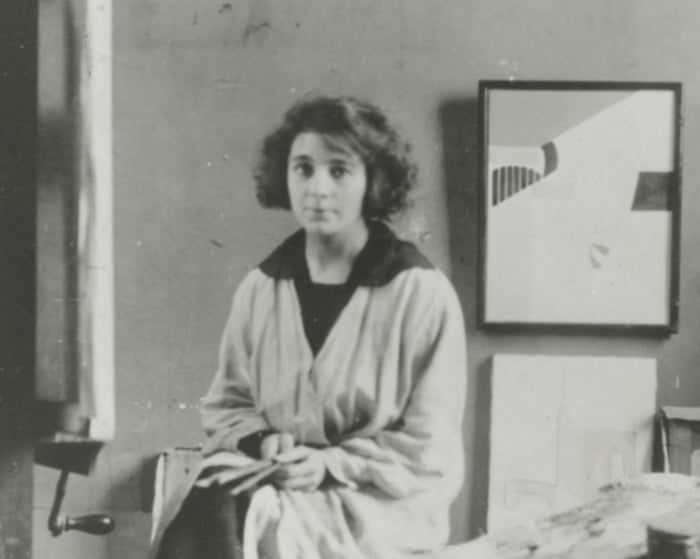In the years of artistic experimentation that followed World War I, critics were fascinated by the mysterious modernist known as Tour Donas. One wrote, “There is a charm in Tour Donas’s work that we don’t usually see in painters of his school—a gentle shyness that suggests a feminine sensitivity.” In reality, his work was hers: Marthe Donas, a Belgian artist who adopted a gender-neutral name to succeed in the male-dominated art world.
As Tour Donas, Marthe enjoyed a brief but brilliant career before fading into obscurity. Now, her hometown of Antwerp is honoring her with a major exhibition, placing her among modernism’s greats like Piet Mondrian, Amedeo Modigliani, and her mentor and partner, Ukrainian sculptor Alexander Archipenko.
Opening Saturday at Antwerp’s Royal Museum of Fine Arts (KMSKA), the exhibition features 55 of her works, ranging from warm-toned cubist paintings and shimmering textile impressions to flatter abstract pieces. Donas is presented alongside Archipenko and La Section d’Or, a pan-European group of artists and writers who aimed to advance modernism without cliques or manifestos.
The show highlights a different side of modernism—less shocking than Marcel Duchamp’s urinal or as stark as Kazimir Malevich’s black square. Curator Adriaan Gonnissen notes that for Donas and Archipenko, “abstraction and elegance go hand in hand. There’s a real drive for innovation, but also a deep hunger for classical beauty.” Unlike radicals like Duchamp or Jackson Pollock, La Section d’Or took a more measured approach.
One of the exhibition’s most treasured works is The Dance, painted by Donas in 1918–19. Long considered lost, it was rediscovered in Japan during preparations for this show.
Born in 1885 to a well-off French-speaking family in Antwerp, Donas came from artistic roots—her grandfather was a realist painter. But her father disapproved of her pursuing art and withdrew her from art school after just one month in 1902. A decade later, after a life-changing accident, she re-enrolled, determined to become an artist. She had fallen through a glass ceiling while trying to catch a glimpse of King Albert I visiting Antwerp. Her studies were interrupted again by the German invasion in 1914. While her family fled to the Netherlands, Marthe went to Dublin, where she studied stained glass. After a pivotal but costly stay in Paris, she moved to the French Riviera as a drawing instructor for a wealthy woman.
In Nice in 1917, Donas met Archipenko, and the two quickly connected. He called her “my best student” and championed her work. Donas began creating shaped paintings, moving beyond traditional rectangles to emphasize cubist distortions with unique forms.
While modern shaped paintings are often credited to Hungarian artist Peter László Péri, Gonnissen believes Donas was the first of her generation to pioneer this “totally different art form.” Yet her contributions were overlooked, as cubism and abstract art were then seen as male domains—too intellectual and rational for women.
Over a century later, Donas is finally gaining recognition. KMSKA, which reopened in 2022 after extensive renovations, is committed to highlighting female artists in its collection. Before the update, the museum owned only one of her works, which wasn’t always on display.
This exhibition is part of a growing effort to rediscover overlooked female masters, such as Baroque artist Artemisia Gentileschi and her contemporaries.Michaelina Wautier, a lesser-known artist from the southern Netherlands, has been featured in recent exhibitions, much like American impressionist Mary Cassatt and Spanish modernist Maruja Mallo, whose works have also been rediscovered from storage.
Art historian Peter Pauwels has dedicated twenty years to raising awareness of Donas, whose work he praises for its elegance, color, originality, and beauty. As an expert in Belgian modernism, Pauwels was familiar with Donas’s art through his grandparents’ collection, though she remained obscure in the Flemish art scene two decades ago. Pauwels, who co-curated the exhibition, challenges the dismissive attitude of Donas’s peers, emphasizing that she was not a novice but a 32-year-old established artist when she met Archipenko.
By mid-1921, Donas and Archipenko had parted ways. Donas married and relocated to the Walloon countryside, while Archipenko moved to America. Her artistic presence faded from the late 1920s after she became a mother unexpectedly at age 45, remaining absent for twenty years. Later in life, Donas minimized her association with Archipenko, stating she had only worked in his studio for a few months.
The exhibition highlights a powerful creative energy in her work, concluding with two pieces: one by Donas that seems influenced by an Archipenko sculpture she retained after their separation. Though the vibrant colors and curves of both works complement each other, Pauwels notes that Donas always added her unique touch and never resorted to imitation.
“Donas, Archipenko & La Section d’Or. Enchanting Modernism” is on display at the Royal Museum of Fine Arts in Antwerp (KMSKA) until January 11, 2026.
Frequently Asked Questions
Of course Here is a list of FAQs about Marthe Donas and her recognition in Belgium designed to be clear concise and natural
General Beginner Questions
1 Who is Marthe Donas
Marthe Donas was a pioneering Belgian modernist artist known for her abstract and cubist paintings She was a key figure in the avantgarde art scene of the early 20th century
2 Why is Belgium celebrating her now
For decades her work was largely overlooked and forgotten Recent exhibitions and art historical research have brought her significant contributions back into the spotlight leading to a welldeserved celebration of her legacy
3 What kind of art did she make
She primarily created abstract and cubist paintings Her work often features geometric shapes bold lines and a dynamic sense of composition moving away from realistic representation
4 When did she live and work
She was active from the early 1910s until around the 1960s Her most innovative period was during the 1910s and 1920s when she was deeply involved with the European avantgarde
5 Where can I see her art in Belgium
Major museums like the Royal Museums of Fine Arts of Belgium in Brussels and the M HKA have featured her work in exhibitions and hold pieces in their collections
Deeper Advanced Questions
6 Why was her talent overlooked for so long
A major reason was her gender The art world of her time was heavily maledominated making it difficult for female artists to gain the same recognition as their male counterparts She also sometimes exhibited under a male pseudonym which obscured her identity
7 What was her connection to the wider art world
She was deeply connected She lived and worked in Paris interacted with famous artists and thinkers and exhibited alongside major figures of Cubism and Modernism
8 Did she use a pseudonym
Yes For a time she signed her paintings with the male pseudonym Tour Donas to be taken more seriously by galleries and critics which is a telling sign of the challenges she faced
9 How does her work compare to more famous male modernists
Her work stands shouldertoshoulder with pioneers like Picasso and Braque in its exploration of Cubism Her unique contribution lies in her distinctive approach to




